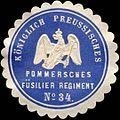This article needs additional citations for verification .(October 2022) |
The 34th (Pomeranian) Fusiliers "Queen Victoria of Sweden" [1] was a regiment of the Royal Prussian Army, and later of the Imperial German Army until the end of the First World War. The regiment was first founded under the rule of the Swedish Empire in 1720, under the name the Queen's Life Regiment of Foot (Swedish : Drottningens livregemente till fots). It was an enlisted infantry regiment that was set up in Stralsund in 1720, during the Great Northern War. It operated under Swedish rule until 1815, when the regiment was transferred together with the dominion of Swedish Pomerania to Prussia following a decision at the Congress of Vienna.
Contents









